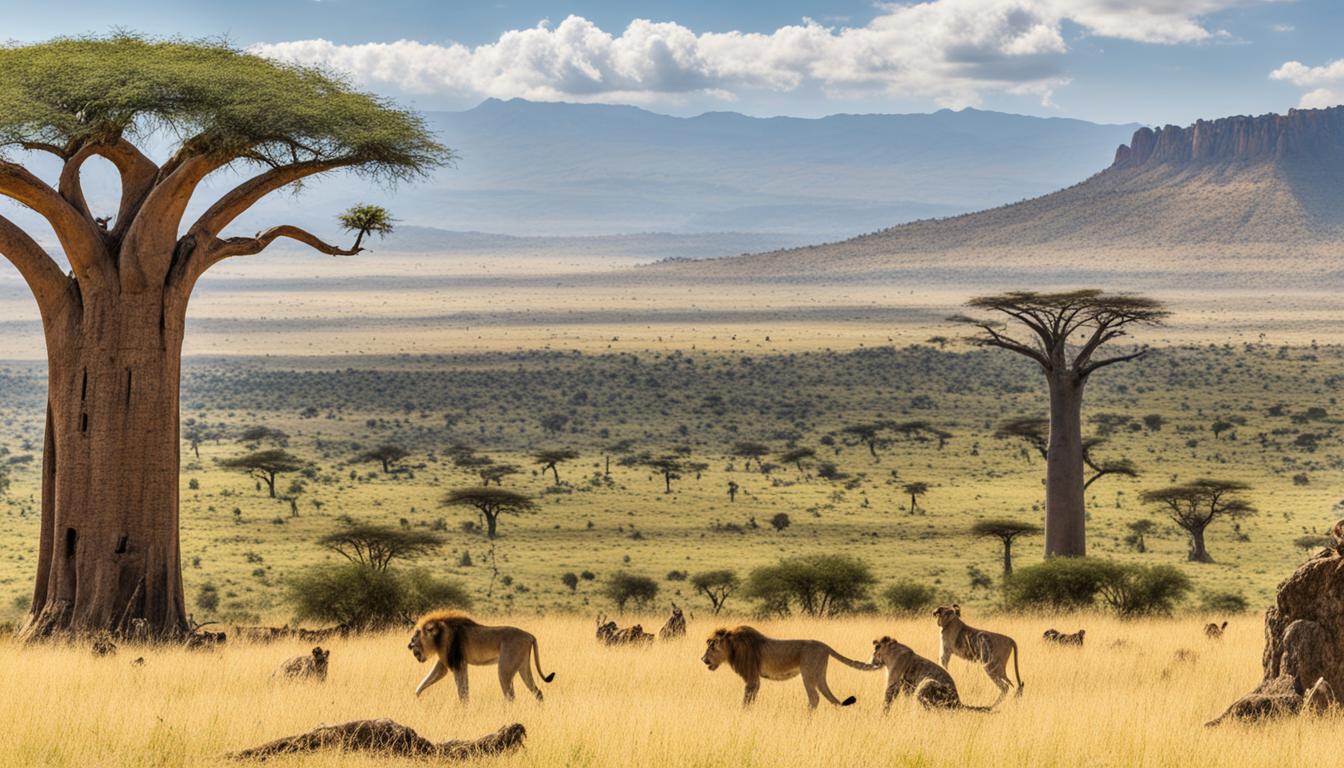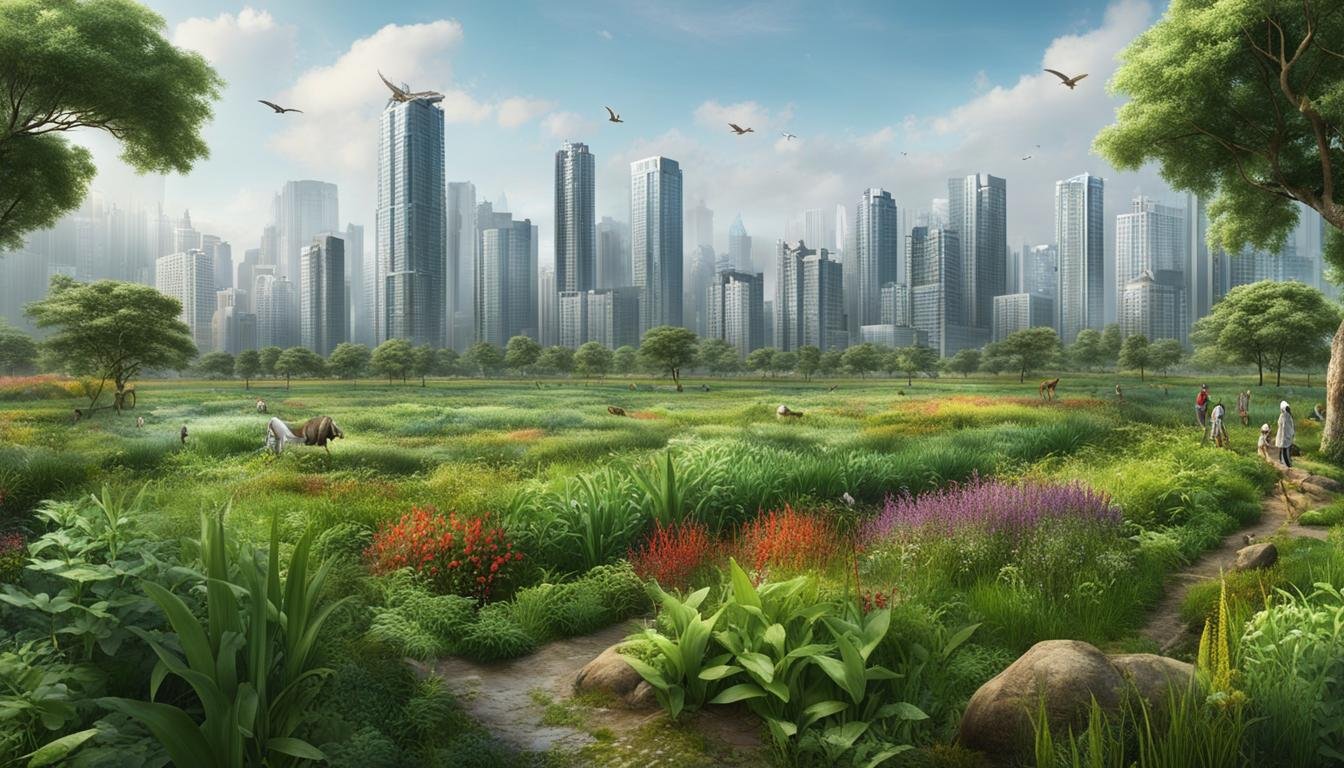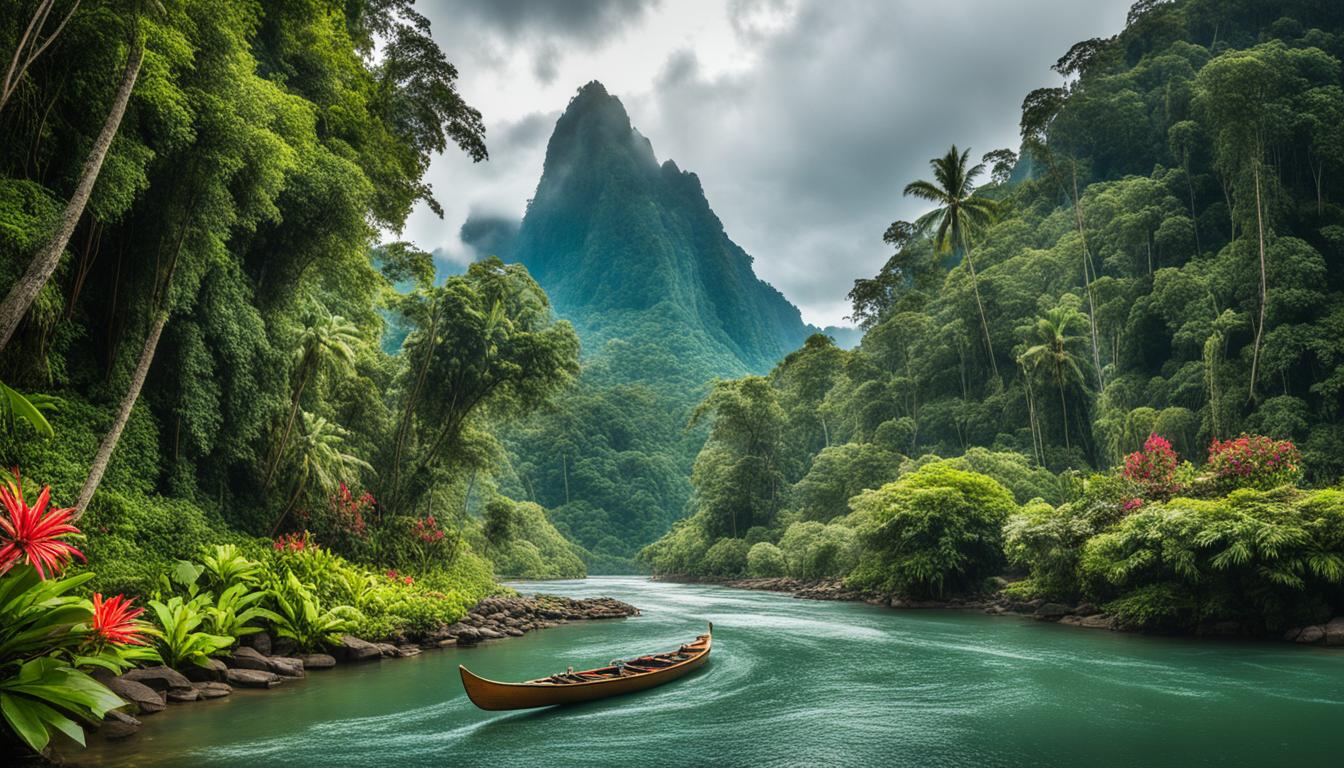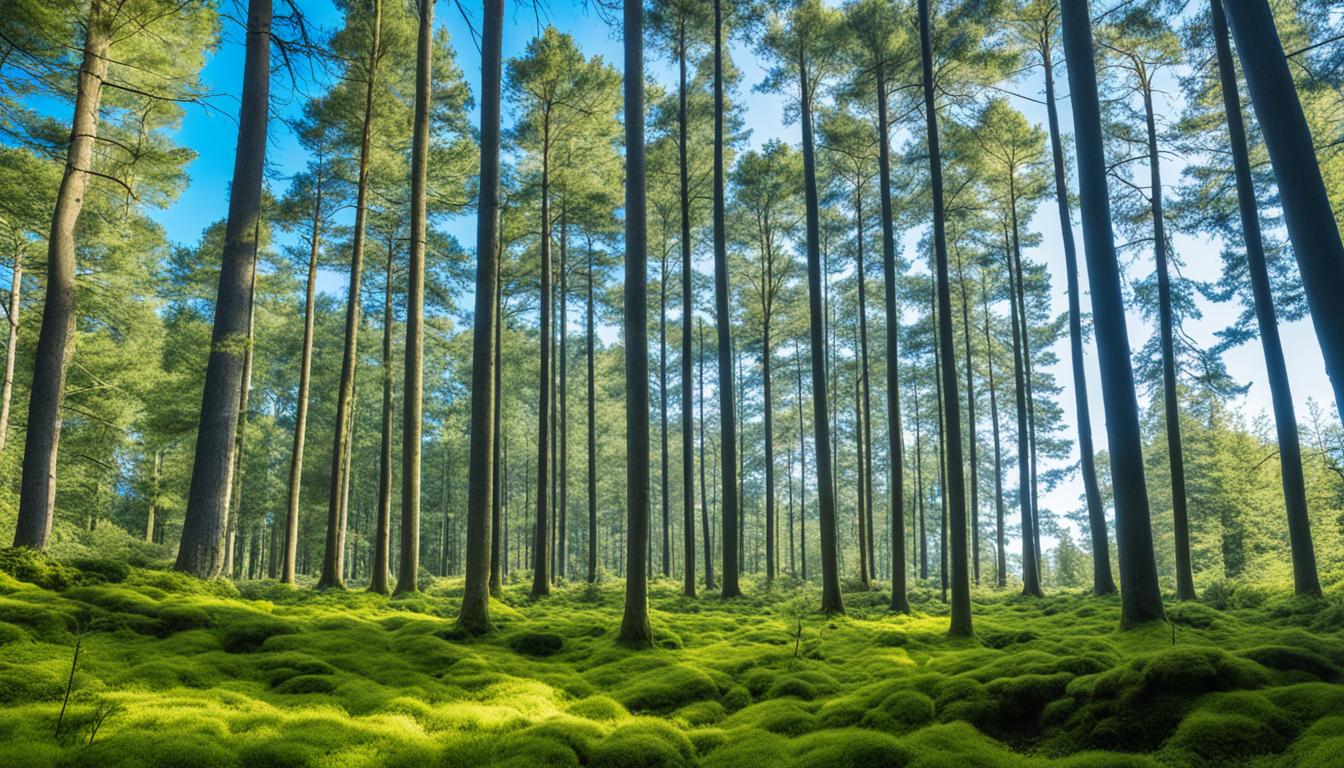Fiji Biodiversity: Animal and Plant Species and What Is Under Threat
Did you know that Fiji, a small nation consisting of over 300 islands, is home to remarkable biodiversity, including endemic species not found anywhere else in the world? Fiji’s forests cover more than half of its landmass, and the country boasts approximately 2,600 vascular plants, 27 reptile species, and diverse marine habitats. However, the staggering truth is that many of Fiji’s precious species are already under threat or endangered, both on land and in the ocean, due to human-induced factors.
Key Takeaways:
- Fiji is renowned for its exceptional biodiversity, with unique species that cannot be found elsewhere in the world.
- Habitat loss, pollution, overfishing, and the introduction of invasive species are some of the major threats facing Fiji’s biodiversity.
- Fiji’s endangered species, such as marine turtles, humpback whales, and parrotfish, require immediate conservation efforts.
- Conserving biodiversity is essential for ecosystem stability, species interdependence, and the preservation of genetic material.
- Efforts such as protected areas, community involvement, and environmental education play a crucial role in safeguarding Fiji’s biodiversity.
The Rich Biodiversity of Fiji
Fiji is renowned for its remarkable biodiversity, boasting a diverse array of unique species found nowhere else in the world. From vibrant forests to captivating marine habitats, the islands of Fiji are teeming with life.
The lush forests of Fiji cover more than half of its landmass, providing a sanctuary for a variety of plant and animal species. With over 1600 native vascular plants, Fiji’s forests are a treasure trove of botanical wonders. From towering trees to delicate ferns, these forests are a paradise for nature enthusiasts.
The marine habitats surrounding Fiji’s islands are home to an astounding number of species. The coral reefs, mangroves, and seagrass beds support a wide diversity of fish and invertebrates, creating a vibrant underwater ecosystem. Exploring Fiji’s marine habitats is like diving into a world of colorful corals, graceful sea turtles, and elusive reef sharks.
What makes Fiji’s biodiversity truly extraordinary is its endemic species. The islands are home to 27 endemic reptile species, found nowhere else on Earth. These unique reptiles showcase the evolutionary wonders of Fiji’s isolated ecosystems.
“Fiji’s biodiversity is unmatched, with its stunning native plants, reptiles, and marine life. Exploring these natural wonders is an experience like no other.” – Marine biologist, Dr. Sarah Thompson
Fiji’s rich biodiversity extends to its endemic plants, which have adapted to the distinct environmental conditions of the islands. These endemic plants play a crucial role in maintaining the balance of Fiji’s ecosystems, providing habitats and food sources for various animals.
Imagine walking through a forest in Fiji, surrounded by lush greenery, with the melodies of unique bird species filling the air. This is the magic of Fiji’s biodiversity.
The significance of Fiji’s biodiversity reaches far beyond its natural beauty. It contributes to the country’s economy through sustainable tourism and the responsible use of natural resources. Preserving Fiji’s biodiversity ensures the continued prosperity of the nation and the well-being of its people.
| Key Features of Fiji’s Biodiversity | Number of Species |
|---|---|
| Vascular Plants | Over 1600 |
| Endemic Reptile Species | 27 |
| Marine Species | Varies, numerous |
Threats to Fiji’s Biodiversity
Fiji’s biodiversity faces various threats due to the rapid pace of economic development. These threats have the potential to significantly impact the rich natural heritage of the islands. Some of the key challenges include habitat loss, pollution, overfishing, and the introduction of invasive species.
Habitat Loss
Habitat loss is a major concern in Fiji, particularly in relation to deforestation and the conversion of land for agriculture purposes. Forests, covering over 52.6% of the landmass, are being cleared to make way for agricultural activities, resulting in the loss of critical habitats for many species. Similarly, mangroves, essential for coastal biodiversity and protection against natural disasters, are being reclaimed for construction and commercial purposes, further exacerbating the problem.
Pollution
Pollution caused by agricultural and industrial activities poses another significant threat to Fiji’s biodiversity. The discharge of pollutants into rivers, lakes, and coastal waters degrades the water quality and harms the ecosystems that many species rely on for survival. This pollution can result in the decline of sensitive species, disruption of food chains, and overall ecosystem imbalance.
Overfishing
Overfishing, driven by the high demand for seafood, is a pressing concern for Fiji’s marine biodiversity. Unsustainable fishing practices, such as the use of destructive gear and overexploitation of fish stocks, can lead to population declines and disrupt the delicate balance of marine ecosystems. This directly impacts the livelihoods of coastal communities that depend on fishing for sustenance and income.
Invasive Species
The introduction of invasive species is yet another threat to Fiji’s biodiversity. These non-native species, often brought to the islands accidentally or intentionally, can outcompete and prey upon native species, leading to their decline or extinction. Invasive species can disrupt ecological processes, alter natural habitats, and cause irreparable damage to Fiji’s delicate ecosystems.
The combined effects of habitat loss, pollution, overfishing, and invasive species have already resulted in the endangerment of many species in Fiji. For instance, 25% of bird species, 11.7% of mammals, and 67% of amphibians are currently at risk.
Protecting Fiji’s biodiversity is essential for maintaining the ecological balance of the islands and safeguarding their unique natural heritage.
Table 3: Threats to Fiji’s Biodiversity
| Threats | Impact |
|---|---|
| Habitat Loss | Loss of critical habitats for many species |
| Pollution | Water and habitat degradation, disruption of food chains |
| Overfishing | Population declines, disruption of marine ecosystems |
| Invasive Species | Competition, predation, and disruption of native species |
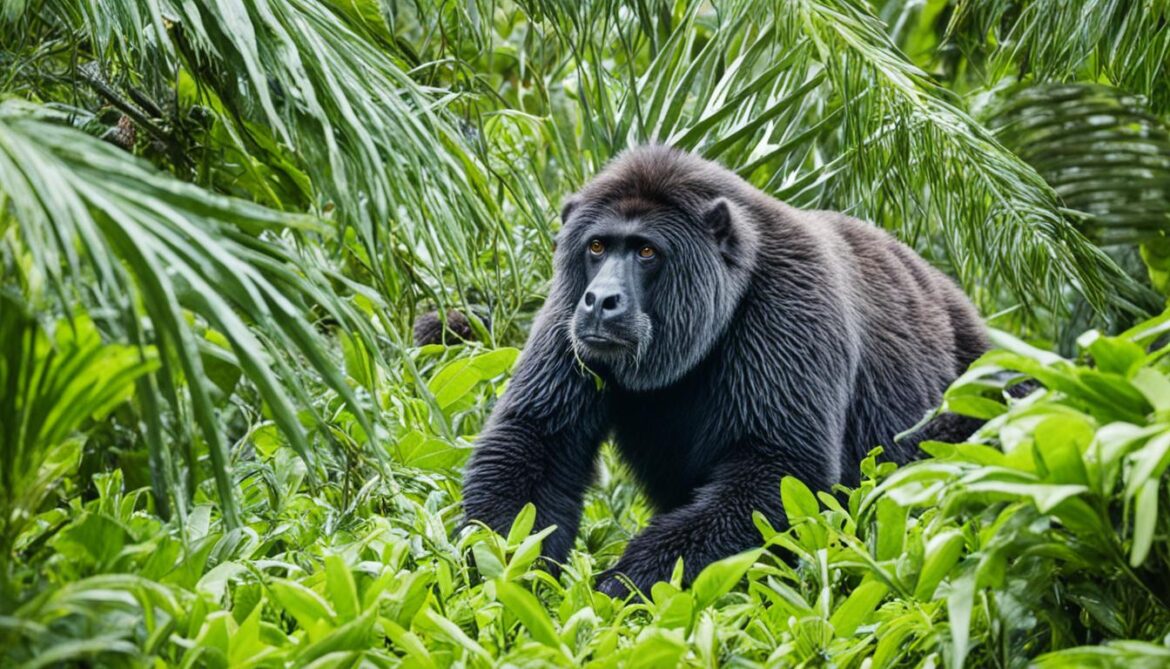
Endangered Species in Fiji
Fiji is blessed with diverse ecosystems that are home to several endangered species, representing the rich biodiversity of the region. The fragile marine and terrestrial habitats of Fiji support a variety of remarkable creatures facing grave challenges for their survival. As conservation efforts intensify, it becomes crucial to protect these species and ensure the preservation of Fiji’s unique natural heritage.
Among the endangered species in Fiji, marine turtles, including the Hawksbill and Green turtles, face significant threats. These graceful creatures play a vital role in the marine ecosystem, but habitat loss, pollution, and uncontrolled fishing practices endanger their population.
Fiji’s pristine waters are also home to humpback whales, whose migratory paths bring them to Fiji’s shores. These majestic mammals face threats such as entanglement in fishing gear and vessel strikes due to increased maritime activities in their habitat.
The parrotfish and wrasse species in Fiji are also classified as endangered, primarily due to overfishing and habitat degradation. These vibrant and essential fish species contribute to the health of coral reefs and play a crucial role in maintaining the delicate balance of Fiji’s marine ecosystems.
Fiji’s shores are adorned with a variety of exquisite shells, each with its distinctive beauty. However, the harvesting of shells for commercial purposes has significantly impacted shell-bearing marine organisms. From the iconic cowrie shells to the intricate cone shells, efforts to protect these valuable mollusks are essential for their survival.
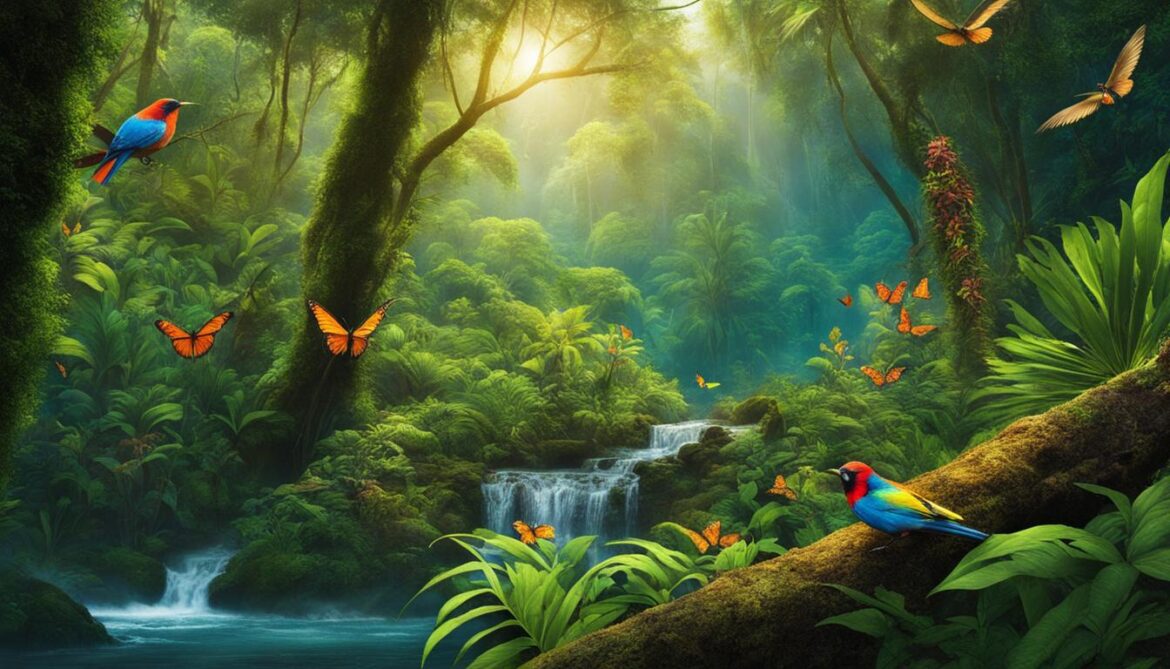
The Fiji Department of Fisheries recognizes the vulnerability of these species and has identified them as a priority for conservation efforts. Collaborative initiatives between local communities, NGOs, and government agencies are aimed at preserving the biodiversity and ecological balance of Fiji’s ecosystems.
Conservation measures, such as the establishment of protected areas and the enforcement of regulations, serve as crucial steps towards safeguarding endangered species. It is imperative to raise awareness about the importance of these species and their habitats to inspire active participation in conservation efforts.
By protecting Fiji’s endangered species, we not only preserve their inherent beauty but also contribute to the overall health and resilience of Fiji’s ecosystems. These creatures are integral to the web of life, and their survival is a testament to the positive impact of concerted conservation actions.
Causes of Species Endangerment
Several factors contribute to the endangerment of species in Fiji. Pollution from various sources, including oil spills and toxic substances, can have devastating effects on organisms. Habitat loss, often due to human activities such as construction and agriculture, is the most significant cause of species endangerment. Disease, unregulated fishing, the introduction of invasive species, and competition for resources also play a role. It is essential to address these factors to protect Fiji’s biodiversity.
Pollution poses a significant threat to Fiji’s species. Oil spills and the release of toxic substances into the environment can have severe consequences for organisms’ health and survival. These pollutants can contaminate water bodies, disrupt ecosystems, and harm marine life, including fish, coral, and turtles.
Habitat loss is another major cause of species endangerment in Fiji. Human activities, such as land clearing for agriculture, deforestation for logging, and infrastructure development, lead to the destruction and fragmentation of natural habitats. As a result, many species lose their homes and are unable to find suitable environments to thrive in.
Diseases also contribute to species endangerment. Outbreaks of infectious diseases can decimate populations, especially in vulnerable species with limited genetic diversity. These diseases can be introduced through various means, including the movement of infected individuals or the introduction of non-native species that act as disease carriers.
Unregulated fishing practices pose a significant threat to marine species in Fiji. Overfishing, which involves catching more fish than can naturally reproduce, can deplete fish populations and disrupt entire marine ecosystems. This not only affects fish species but also impacts other animals that depend on them for food.
The introduction of invasive species is another cause of species endangerment. When non-native species are introduced into an ecosystem, they can outcompete native species for resources, predate on them, or bring new diseases. These invasive species can upset the fragile balance of ecosystems and lead to the decline or extinction of native species.
Competition for resources exacerbates the endangerment of species in Fiji. As human populations grow and economic activities expand, the demand for natural resources increases. This competition for resources, such as land, water, and food, puts additional pressure on species and their habitats, further contributing to their decline.
Key Causes of Species Endangerment:
- Pollution from oil spills and toxic substances
- Habitat loss due to construction and agriculture
- Disease outbreaks and introduction of infectious agents
- Unregulated fishing leading to overexploitation
- Introduction of invasive species
- Competition for resources

The table below highlights some examples of the species endangered by these causes:
| Species | Threats |
|---|---|
| Fiji Petrel | Loss of breeding habitat due to deforestation |
| Giant Clam | Overfishing and harvesting for the aquarium trade |
| Green Turtle | Entanglement in fishing nets and habitat destruction |
| Fiji Ground Frog | Invasive species predation and habitat loss |
Addressing these causes of species endangerment requires a multi-faceted approach. Efforts to reduce pollution, promote sustainable land use practices, regulate fishing activities, control invasive species, and ensure equitable resource management can help protect Fiji’s biodiversity and ensure the survival of endangered species. Conservation initiatives and public awareness campaigns play a crucial role in fostering a sense of responsibility and encouraging collective action for the preservation of Fiji’s unique natural heritage.
Importance of Conservation Efforts
Conserving Fiji’s biodiversity is crucial for maintaining ecosystem stability and ensuring the survival of species. Every organism plays a role in its ecosystem, and the loss of a single species can have cascading effects throughout the food chain.
Ecosystem stability is vital to maintaining the delicate balance of nature. Each plant and animal relies on others for food, shelter, and other important resources. By conserving Fiji’s biodiversity, we safeguard the interconnectedness of species and preserve the complex web of life that sustains our planet.
Furthermore, genetic material preservation is a key aspect of conservation. Fiji’s unique flora and fauna hold valuable genetic information that could lead to scientific discoveries, including new medicines and chemicals. By protecting these species and their genetic material, we unlock the potential for future advancements in various fields.
“Conserving Fiji’s biodiversity is not only essential for environmental and ecological reasons, but also for economic and cultural sustainability.”
The importance of conserving Fiji’s biodiversity extends beyond environmental considerations. It is crucial for economic sustainability as well. Many industries in Fiji, such as tourism and agriculture, rely on the diversity of natural ecosystems to attract visitors and support local livelihoods. By preserving Fiji’s biodiversity, we secure the future prosperity of these industries.
Culturally, Fiji’s biodiversity plays a significant role in the lives and traditions of the local communities. The unique plants and animals are part of their identity and heritage. Protecting Fiji’s biodiversity ensures the preservation of cultural heritage and the continuation of traditional practices.
In conclusion, the conservation of Fiji’s biodiversity is of utmost importance. It contributes to ecosystem stability, protects species interdependence, and preserves valuable genetic material. The benefits reach beyond the environmental realm, encompassing economic prosperity and cultural sustainability. By taking action now, we can secure a brighter future for both Fiji’s ecosystems and its people.
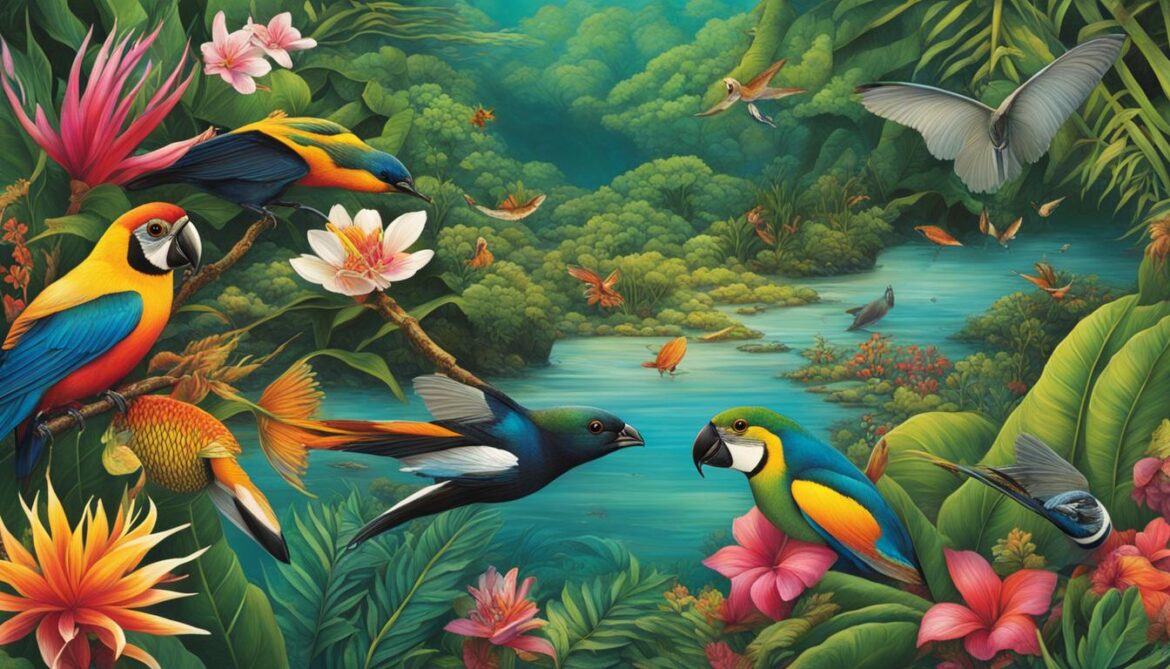
Fiji’s Conservation Measures
Fiji has implemented various conservation measures to protect its biodiversity. These measures are aimed at preserving the unique flora and fauna of the islands and ensuring the long-term sustainability of Fiji’s ecosystems and natural resources.
To safeguard key habitats, Fiji has established protected areas, including Locally Managed Marine Protected Areas (LMMAs) and terrestrial reserves. These protected areas serve as important refuges for endangered species and help maintain the ecological balance of Fiji’s marine and terrestrial ecosystems.
Ecosystem-based management approaches have also been adopted in Fiji. This holistic approach considers the entire ecosystem when making decisions about resource management. By taking into account the interconnectedness and interdependence of species and habitats, ecosystem-based management allows for more sustainable and resilient conservation practices.
In order to regulate the exploitation of its marine and terrestrial resources, Fiji has implemented quota systems for exports. These quotas ensure that the extraction of these resources remains within sustainable limits, preventing overexploitation and depletion of Fiji’s natural resources.
Community involvement is a key component of Fiji’s conservation efforts. Local communities play an active role in the management and protection of natural resources. Through partnerships and collaboration with communities, Fiji promotes sustainable resource use and empowers local stakeholders to take an active role in biodiversity conservation.
Environmental education programs are also implemented to raise awareness and foster a sense of responsibility towards the environment. These programs aim to educate the public, including the younger generation, about the importance of biodiversity conservation and the role individuals can play in protecting Fiji’s natural heritage.
“Conserving Fiji’s biodiversity is a collective effort that requires the active participation of communities, organizations, and individuals.”
Enforcement of environmental regulations is crucial to ensure compliance and deter illegal activities that may harm Fiji’s biodiversity. By enforcing laws and regulations, Fiji aims to prevent activities such as illegal fishing, poaching, and habitat destruction, which pose significant threats to its natural resources.
Fiji also collaborates with non-governmental organizations (NGOs) to strengthen its conservation efforts. These partnerships provide additional resources, expertise, and support to enhance the effectiveness of conservation initiatives.
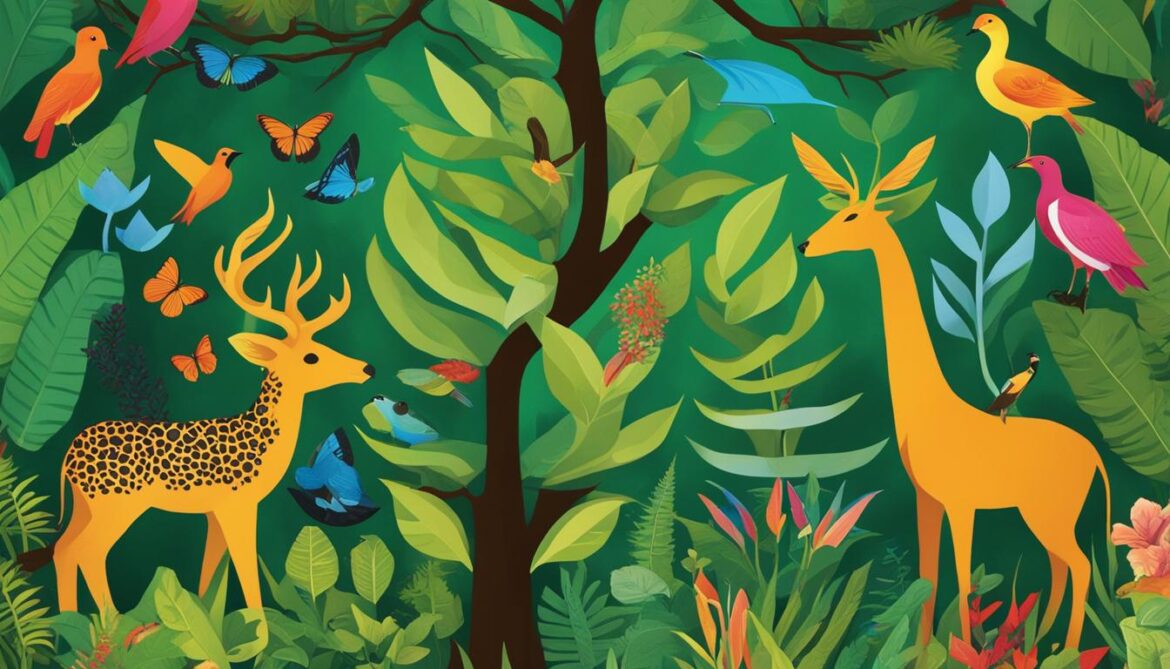
| Conservation Measures | Description |
|---|---|
| Protected Areas | Establishment of LMMAs and terrestrial reserves to safeguard key habitats |
| Ecosystem-based Management | Considering the entire ecosystem for sustainable resource management |
| Export Quotas | Regulating the export of marine and terrestrial resources to prevent overexploitation |
| Community Involvement | Engaging local communities in conservation efforts and sustainable resource management |
| Environmental Education | Raising awareness and fostering a sense of responsibility towards the environment |
| Enforcement | Ensuring compliance with environmental regulations to deter illegal activities |
Support Mechanisms for Conservation
Fiji has implemented various support mechanisms to enhance conservation efforts. These mechanisms play a crucial role in protecting the country’s unique biodiversity and ensuring sustainable development. Through a combination of legislation, funding, capacity-building programs, coordination, and mainstreaming of biodiversity policies, Fiji is taking significant steps towards preserving its natural resources.
Legislation
Under the Environment Management Act, Fiji requires environmental impact assessments for all development projects. This legislation ensures that potential impacts on biodiversity are carefully evaluated before any activities commence. By integrating environmental considerations into the legal framework, Fiji demonstrates its commitment to sustainable practices and the preservation of its rich ecosystems.
Funding
Fiji receives financial support from various sources to bolster its conservation efforts. Organizations such as the Global Environment Facility (GEF), the European Union, and the International Labour Organization provide funding to support biodiversity conservation projects in Fiji. These financial resources enable the implementation of vital initiatives aimed at protecting endangered species and safeguarding valuable habitats.
Capacity-Building
Fiji recognizes the importance of capacity-building programs in enhancing conservation efforts. These programs focus on providing training and resources to individuals and organizations involved in biodiversity conservation. By building the skills and knowledge of local communities, government agencies, and NGOs, Fiji is enabling stakeholders to actively participate in environmental protection and sustainable management.
Coordination
Effective coordination between different government agencies and stakeholders is key to the success of Fiji’s conservation initiatives. Through collaborative efforts, Fiji is able to develop comprehensive strategies, exchange information, and share best practices. This coordination ensures a cohesive approach to conservation, maximizing the impact of the efforts and effectively addressing the diverse challenges faced by Fiji’s biodiversity.
Mainstreaming
Recognizing the need for broad-based engagement, Fiji is dedicated to mainstreaming biodiversity policies into relevant sectors. By integrating conservation principles into sectors such as tourism, agriculture, and fisheries, Fiji is promoting sustainable practices across industries. This approach ensures that biodiversity conservation becomes an integral part of decision-making processes, contributing to the long-term preservation of Fiji’s natural heritage.
The combination of legislation, funding, capacity-building, coordination, and mainstreaming enables Fiji to implement effective support mechanisms for conservation. These efforts demonstrate Fiji’s commitment to protecting its unique biodiversity and ensuring a sustainable future for generations to come.
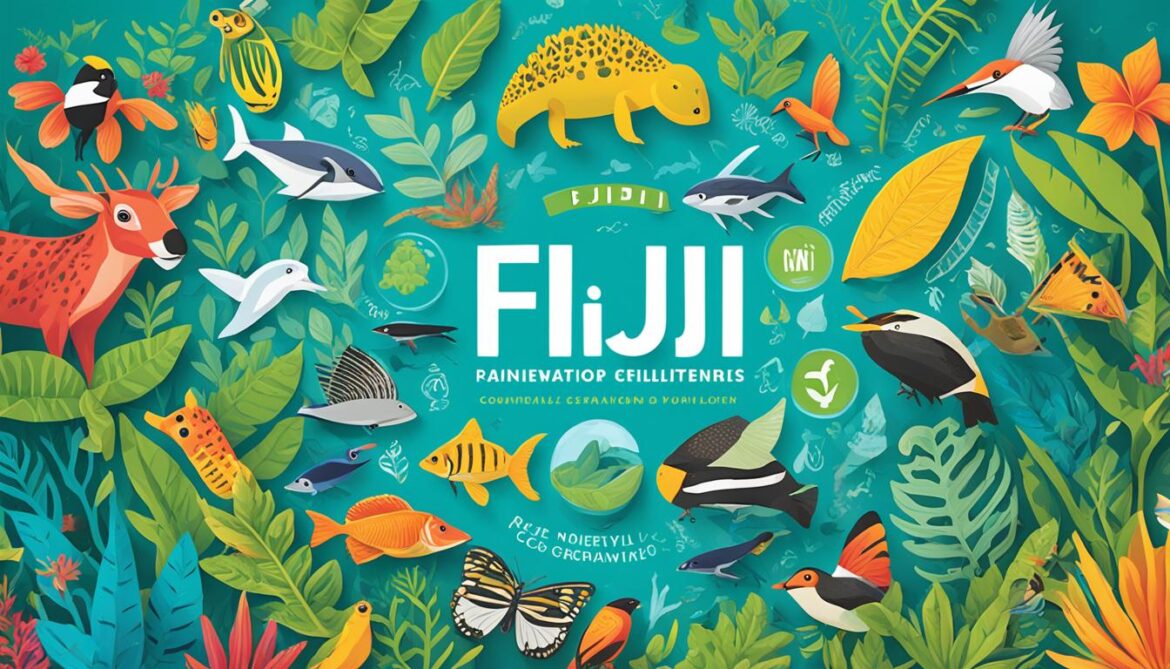
Monitoring and Reviewing Implementation
Fiji recognizes the importance of continuous monitoring and reviewing of its conservation measures to ensure their effectiveness and identify areas that require improvement. Several mechanisms have been put in place to achieve this goal.
Biodiversity Monitoring
Fiji has implemented comprehensive biodiversity monitoring programs that track the status and trends of its diverse ecosystems and species. These programs collect valuable data on wildlife populations, habitat conditions, and threats to biodiversity. The information gathered through biodiversity monitoring enables informed decision-making and helps guide conservation efforts.
Environmental Impact Assessments
As part of the implementation process, Fiji conducts thorough environmental impact assessments (EIAs) for development projects. These assessments evaluate the potential environmental effects of proposed activities and guide decision-makers in minimizing or mitigating any adverse impacts on biodiversity. EIAs ensure that biodiversity conservation is a priority in Fiji’s development plans.
National Strategies and Plans
In line with international commitments, Fiji has developed national strategies and plans specifically focused on biodiversity conservation. These strategies set clear goals, priorities, and targets for safeguarding Fiji’s unique ecosystems and species. They provide a framework for coordinated action and facilitate the integration of biodiversity considerations into various sectors.
Sector Integration
Fiji understands that effective conservation requires the integration of biodiversity considerations across different sectors. There is an emphasis on incorporating biodiversity policies into sectoral plans and programs, such as agriculture, fisheries, and tourism. This integration ensures a holistic approach to conservation and promotes sustainable practices across the board.
Regular monitoring and review of conservation measures are essential to measure their effectiveness and identify areas that require adjustment or additional efforts. By continuously assessing and improving its conservation strategies, Fiji aims to protect its rich biodiversity for future generations.
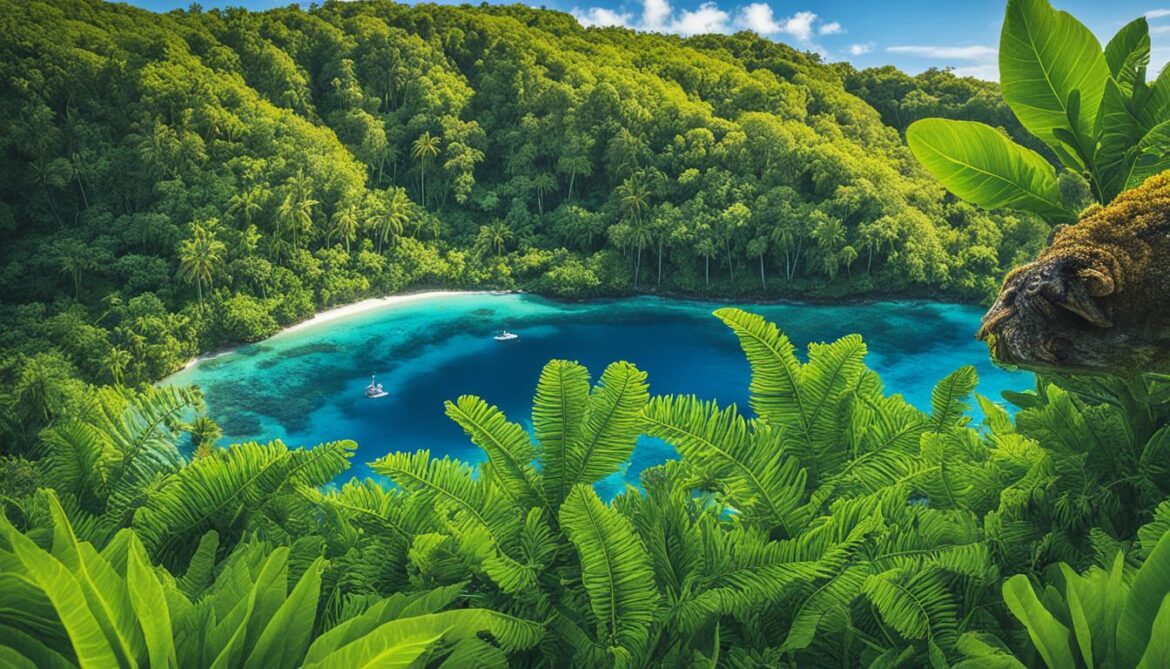
Conclusion
Fiji’s biodiversity is of immense value and uniqueness, but it is under constant threat from human-induced factors. To preserve the rich ecosystems, protect endangered species, and ensure sustainable development, conservation efforts are of utmost importance. The significance of maintaining biodiversity goes beyond environmental considerations. It encompasses economic benefits, cultural heritage, and scientific advancements.
It is imperative that we continue to invest in research, education, legislation, and community involvement. These ongoing efforts are necessary to safeguard Fiji’s biodiversity for future generations. By doing so, we can address the ongoing threats and create a harmonious coexistence between humans and nature, promoting a balanced and resilient environment.
Thus, the need for continued commitment and collaboration in the conservation of Fiji’s biodiversity cannot be overstated. Together, we can ensure the survival of unique plant and animal species, maintain the delicate balance of ecosystems, and reap the numerous benefits that biodiversity brings, both for Fiji and the world at large.




